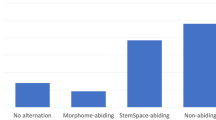Abstract
In the formation of Modern Hebrew denominative verbs, two structural properties are transferred from the base to the derived form: the consonantal root and the consonant cluster. While the model of Root-to-Template Association (McCarthy 1981) is largely based on root transfer, it fails to account for cluster transfer. In this paper I argue that the model which can actually account for cluster transfer as well as root transfer is what I will term here Stem Modification (Steriade 1988). Within this model, segmental and prosodic adjustments are made on the base itself and not on some designated material extracted from the base. This approach to stem formation also eliminates the notion of the consonantal root from the grammar of Modern Hebrew.
Similar content being viewed by others
References
Anderson, Stephen R.: 1992,A-Morphous Morphology, Cambridge University Press, Cambridge.
Archangeli, Diana: 1991, ‘Syllabification and Prosodic Templates in Yawelmani’,NLLT 9, 231–283.
Aronoff, Mark: 1976,Word Formation in Generative Grammar, MIT Press, Cambridge.
Bat-El, Outi: 1984, ‘Reduplication in Modern Hebrew’, paper presented at the Annual Meeting of the Linguistic Society of America, Baltimore.
Bat-El, Outi: 1986, ‘Extraction in Modern Hebrew Morphology’, unpublished M.A. thesis, UCLA.
Bat-El, Outi: 1989, ‘Phonology and Word Structure in Modern Hebrew’, unpublished Ph.D. dissertation, UCLA.
Bat-El, Outi: 1994, ‘Resolving Prosodic Mismatch in Modern Hebrew’, to appear in the Proceedings of the 1st HIL Phonology Conference.
Berman, Ruth A.: 1985, ‘The Acquisition of Hebrew’, in D. I. Slobin (ed.),The Crosslinguistic Study of Language Acquisition, v.1, Lawrence Erlbaum Association, New Jersey, pp. 25–371.
Berman, Ruth A.: 1990, ‘How a New Root is Formed? Denominative Verbs in Modern Hebrew’, paper presented at the 4th annual workshop of the Israel Association for Theoretical Linguistics, Jerusalem.
Blau, Yehoshua: 1972,torat hahége vehacurot, Hakibbutz Hameuchad Publishing, Tel Aviv.
Bolozky, Shmuel: 1978, ‘Word Formation Strategies in the Hebrew Verb System: Denominative Verbs’,Afroasiatic Linguistics 5, 1–26.
Clements, George N.: 1985a, ‘The Geometry of Phonological Features’, in C. J. Ewen and J. M. Anderson (eds.),Phonology Yearbook 2, 225–252.
Clements, George N.: 1985b, ‘The Problem of Transfer in Nonlinear Phonology’,Cornell Working Papers in Linguistics 5, 38–73.
Gesenius: 1910,Gesenius' Hebrew Grammar, E. Kautzsch (ed.), A. E. Cowley (revised), Clarendon Press, Oxford, 2nd English ed. (orig. Halle, 1813).
Guerssel, Mohamed and Jean Lowenstamm: 1994, ‘On Apophony’, to appear in the Proceedings of the 1st HIL Phonology Conference.
Hammond, Michael: 1988, ‘Templatic Transfer in Arabic Broken Plurals’,NLLT 6, 247–270.
Heath, Jeffrey: 1987,Ablaut and Ambiguity: Phonology of a Moroccan Arabic Dialect, State University of New York Press, Albany.
Horvath, Julia: 1981, ‘On the Status of Vowel Patterns in Modern Hebrew: Morphological Rules and Lexical Representation’, in T. Thomas-Finders (ed.),Extended Word-and-Paradigm Theory, Occasional Papers in Linguistics 4, UCLA, pp. 228–261.
Inkelas, Sharon: 1990, ‘Prosodic Replacement in Modern Hebrew’, in K. Deaton et al. (eds.),Papers from the 26th Annual Regional Meeting of the Chicago Linguistic Society, Part 2: Parassession on the Syllable in Phonetics and Phonology, Chicago Linguistic Society, Chicago, pp. 197–212.
Itô, Junko: 1986,Syllable Theory in Prosodic Phonology, unpublished Ph.D. dissertation, University of Massachusetts at Amherst.
Itô, Junko: 1989, ‘A Prosodic Theory of Epenthesis’,NLLT 7, 217–259.
McCarthy, John J.: 1979, ‘Formal Problems in Semitic Phonology and Morphology’, unpublished Ph.D. dissertation, MIT, distributed by Indiana University Linguistic Club, Bloomington.
McCarthy, John J.: 1981, ‘A Prosodic Theory of Nonconcatenative Morphology’,Linguistic Inquiry 12, 373–418.
McCarthy, John J.: 1984, ‘Prosodic Organization in Morphology’, in M. Aronoff and R. T. Oehrle (eds.),Language Sound Structure, MIT Press, Cambridge Massachusetts, pp. 299–317.
McCarthy, John J.: 1986, ‘OCP Effect Gemination and Antigemination’,Linguistic Inquiry 17, 207–263.
McCarthy, John J.: 1989, ‘Linear Order in Phonological Representations’,Linguistic Inquiry 20, 71–88.
McCarthy, John J.: 1993, ‘Template Form in Prosodic Morphology’, in L. S. Stran (ed.), Papers from the 3rd annual meeting of the Formal Linguistics Society of Mid-America, pp. 187–218.
McCarthy, John J. and Alan Prince: 1986, ‘Prosodic Morphology’, unpublished manuscript, University of Massachusetts at Amherst and Brandeis University.
McCarthy, John J. and Alan Prince: 1990, ‘Foot and Word in Prosodic Morphology: The Arabic Broken Plural’,NLLT 8, 209–283.
Mester, Armin R.: 1988,Studies in Tier Structure, Garland, New York.
Mutaka, Ngessimo and Larry M. Hyman: 1990, ‘Syllable and Morpheme Integrity in Kinande Reduplication’,Phonology 7, v.1, 73–119.
Ornan, Uzi: 1971, ‘binyanim ubsisim, netiyot ugzirot’, HaHa ? universita 16, 15–22.
Schwarzwald, Ora: 1973–74, ‘šorašim, bsisim umivne hamorfémot’,Lešonenu 38, 131–136.
Selkirk, Elisabeth: 1984, ‘On the Major Class Features and the Syllable Theory’, in M. Aronoff and R. T. Oehrle (eds.),Language Sound Structure, MIT Press, Cambridge, pp. 107–144.
Steriade, Donca: 1988, ‘Reduplication and Syllable Transfer in Sanskrit and Elsewhere’,Phonology 5, v.1 73–155.
Wexler, Paul: 1990,The Schizoid Nature of Modern Hebrew: A Slavic Language in Search of a Semitic Past, Otto Harrassowitz, Wiesbaden.
Yannai, Yigal: 1973–74, ‘pe?alim merubei?icurim balašon ha?ivrit’, LeLešonenu 38, 118–130, 183–194.
Yip, Moira: 1988, ‘Template Morphology and the Direction of Association’,NLLT 6, 551–577.
Author information
Authors and Affiliations
Additional information
I am grateful to Sharon Inkelas, Wendy Sandler, Donca Steriade, and two anonymous NLLT readers for their valuable comments on earlier drafts of this paper, and to Michele Segal for her editorial work. I alone am responsible for any errors found herein.
Rights and permissions
About this article
Cite this article
Bat-El, O. Stem modification and cluster transfer in Modern Hebrew. Nat Lang Linguist Theory 12, 571–596 (1994). https://doi.org/10.1007/BF00992928
Received:
Revised:
Issue Date:
DOI: https://doi.org/10.1007/BF00992928




